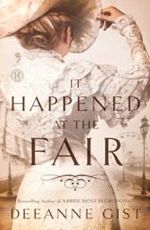Best-selling author, Deeanne Gist, shares with readers her inspiration behind the story of her latest book, It Happened at the Fair (Howard Books).
Q: As a historical novelist, how do you pick the settings and events that provide the backdrop to your stories?
I'm always drawn to events in our country's past that are strangely absent from our history classes. Why the 1893 World's Columbian Exposition has been left out, I don't know, especially since it was such a pivotal event for us. It set the standard for architecture in the upcoming century; it introduced foreign cultures to our amazed population. It wowed the world with our scientific innovations, and it gave women their first official, recognized board position and approved by an Act of Congress (all before we had the right to vote). But it was technology that claimed the day as it nipped at the heels of horses, buggies and man-powered tools. Between that and the evocative backdrop that lent itself to so many possibilities, how could I resist?
Q: Was there something specific that you found in the research process that drove the plot for It Happened at the Fair?
When I knew that I wanted to set the story at the 1893 Chicago World's Fair, I went to the reference part of the library and found two huge, oversized albums filled with pictures and descriptions. In one was a picture of a woman teaching children. It turned out, she and the children were part of an exhibit and she was teaching them to lip read. I ground to a halt and immediately thought of all kinds of fun scenarios that could take place with a heroine that could lip read. And It Happened at the Fair was born.
Q: What were some of your other favorite details you discovered about the fair?
All of them were my favorite! So much so, I had a horrible time trying to decide what details to leave out. I read thousands of pages about the Fair, its exhibits and its programs. All of them fascinating, all of them worthy of being included. Some that I found particularly interesting were among the applications submitted for exhibit space.
One hopeful wanted to make a suite of apartments beneath the waters of Lake Michigan. Someone from England wanted to be placed on exhibition as the Messiah. A father of an "infant prodigy" wanted his baby to introduce the leading orator at the dedication ceremonies. And a vendor of cosmetics wanted to "varnish" half of a "wrinkled hag's" face with his products and at the end of the Fair reveal her features (on that half) to be "sleek and smooth."
Q: I've read that you are quite a collector, especially items related to the time periods of your books and your main characters. Have you been able to collect anything related to the 1893 World's Fair?
Since writing It Happened at the Fair, I have become captivated by everything Fair related. I've collected books, of course, but I've also managed to snag a set of silver spoons with different buildings engraved into their bowls. I also have a set of hand painted postcards. Did you know the 1893 Chicago World's Fair invented picture postcards? People had never seen them before, but they quickly became extremely popular and an entire new industry was born.
I've also acquired a silver half-dollar minted specifically for the Fair, an original admission ticket, and a full-color panoramic view of the Fair. But my pièce de résistance is a full deck of 1893 World's Columbian Exposition playing cards. All fifty-two of them plus the joker. I can't tell you how my imagination spins when I hold those cards in my hand. Cards that someone else held for the first time one-hundred-twenty years ago. Who bought them? Where in the Fair were they? Which card games were their favorites? Why are they in such pristine condition? Were they so coveted that they were afraid to use them lest they wear them out? The questions in my head go on and on, then I carefully tuck them back into their box so as to preserve them for someone else who in, say, one-hundred-twenty years just might ask those same questions.
Q: One last question for you-but this one isn't fair related. Most authors include a "moral of the story" into their novels to leave readers with. Is there a message you hope readers walk away with after reading It Happened at the Fair?
Through my characters, I hope readers will see that God is big enough to overcome all your limitations, either real or perceived. Lean on Him rather than on your own understanding.


